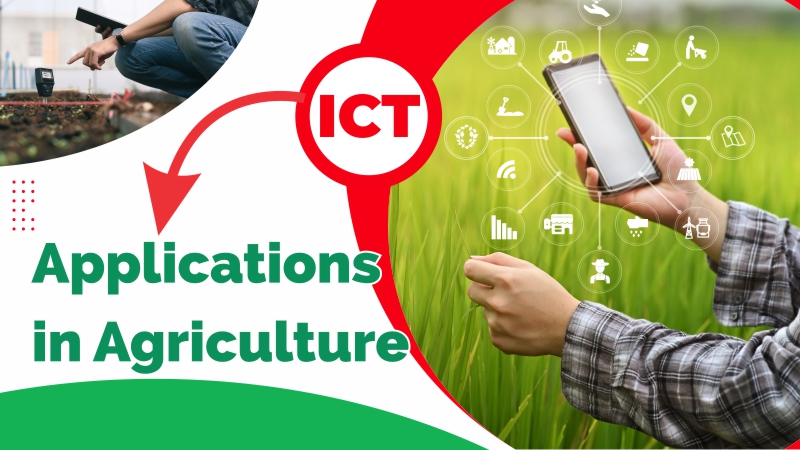The goal of information and communication technology in agriculture (ICT in agriculture), commonly referred to as e-agriculture, is to improve information and communication systems in order to advance agricultural and rural development. In more detail, e-agricultural includes the conception, design, development, testing, and implementation of novel information and communication technology (ICT) applications in the rural domain, with a primary focus on agriculture. Devices, networks, mobiles, services, and applications all fall under ICT. These range from cutting-edge Internet-era technology and sensors to other traditional aids like landlines, televisions, radios, and satellites.
The use of (ICT) in agricultural and rural development is now a reality. The efficiency of smallholder agriculture has already grown thanks to mobile devices. There are now even more advanced ICT uses on the rise, such as satellite and remote technologies for food traceability, sensory detection, real-time reporting, and field status updates.
ICT in Agriculture:
The networks, mobiles, devices, services, and applications that facilitate the processing, management, and sharing of data, information, or knowledge with a target audience are referred to as information and communication technologies (ICT) in agriculture technology. They cover a wide range of convergent technologies, including conventional telecoms, television, radio, CD-ROMs, mobile phones, smart gadgets, and various contemporary ones like computers, the internet, sensors, satellites, Geographic Information Systems, and so on. ICT’s main objective is to move information from one place to another.
Impact of ICT in Agriculture:
ICT opens up significant prospects for the agriculture industry, which employs over 40% of the global workforce and accounts for a sizable share of exports from developing nations. To solve the problem of food security, rural communities must increase their yields, productivity, and incomes.
ICTs have significantly changed how people, governments, and enterprises of all sizes operate in the modern world. Nearly 60% of people worldwide have access to the internet, and mobile internet is currently the most popular method of accessing the internet globally. ICT has been widely adopted, allowing for improved communication and the supply of services and information to people who previously lacked access.
The introduction of new, cutting-edge agricultural technologies has enabled the industry to advance globally and revolutionize how farmers cultivate, harvest, and distribute agricultural products. The use of creative strategies to enhance the current information and communication processes has hastened agricultural and rural development through the use of technology in Indian agriculture, or e-agriculture. In many agrarian economies, it has transformed smallholder agriculture in particular and helped with a number of issues related to the conventional form of agriculture.
Benefits of ICT in Agriculture:
- It can launch new agricultural and rural businesses including e-commerce, satellite office real estate, rural tourism, and virtual small-scale farm corporations.
- Utilizing techniques like geographic information systems can support policy-making and evaluation for the management of agro-environmental resources, disaster management, and optimal farm output.
- Effective farm management, risk management, information or knowledge transmission, etc., can enhance farm management and agricultural technology, enabling competitive and sustainable farming with safe products.
- It can offer tools and systems to ensure food traceability and reliability, which has been a problem with farm products.
- It can facilitate rural activities and offer more secure and comfortable rural living with services comparable to those in metropolitan areas, such as the provision of remote public services, entertainment, and telemedicine.
- Effective resource management (development, conservation, allocation, and use.
- Farmers’ profitability and production were increased thanks to better advice systems.
How ICT is changing the lives of farmers?
Empowering Small landholders: Using ICT in agriculture enables farmers to increase agricultural output by providing them with crucial information about planting, crop protection, and enhancing soil fertility. In order to avert substantial crop loss, they can better plan for infrequent events like floods, droughts, and even pest and disease outbreaks with the aid of weather-related forecasts and notifications. In order to ensure they obtain fair compensation for their produce, ICTs also give them a dependable way to look for the greatest market price in the neighborhood marketplaces.
Now that they have access to low-cost mobile devices, it is simpler for them to get more information and services that help them make informed decisions.
Agriculturists can now link with the worldwide network of farmers, agronomists, businesses, and other service providers to stay current on the latest crop cultivation techniques thanks to the usage of the most recent technology in agriculture.
Farmers who live in distant places have an added edge thanks to the growing availability of inexpensive mobile phones and the internet.
Developing and revolutionizing Agriculture
On a different scale, the application of ICT in modern agriculture has also profoundly changed farming and agriculture in industrialized nations. Big Data, Cloud Computing, and the Internet of Things have all significantly improved the effectiveness of current procedures. Several farm holdings use sensing technology, drones, and other tools to remotely manage farms while collecting crucial information on the characteristics of the soil, the air, the health of the crops, and the weather.
The information gives farmers and agribusinesses the ability to closely monitor crop production, use natural resources and agrochemicals more effectively, and quickly adjust to changing environmental conditions. Efficiency has grown and expenses have decreased as a result of the usage of ICT and precision agriculture equipment. Additionally, it has provided decision-making tools that increase agricultural productivity and aid in efficient resource management.
Internet of things, for example, has several uses in agriculture, ranging from tracing a product’s origin, its environmental impact, and its storage options throughout the supply chain to in-situ sensors used for real-time soil, plant, and animal health monitoring.
Prior disaster warning for management of crops:
Governments and communities can use ICT to get real-time, actionable information on crisis management and prevention. By giving the farmers timely advice on risk management techniques, they help improve the effectiveness of responding during emergency circumstances and foster more effective communication.
To get the latest updates on the tractor, tractor price, and tractor news install the KhetiGaadi application.



